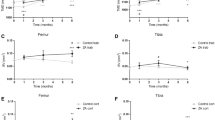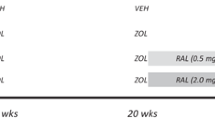Abstract
Differences in the binding affinities of bisphosphonates for bone mineral have been proposed to determine their localizations and duration of action within bone. The main objective of this study was to test the hypothesis that mineral binding affinity affects bisphosphonate distribution at the basic multicellular unit (BMU) level within both cortical and cancellous bone. To accomplish this objective, skeletally mature female rabbits (n = 8) were injected simultaneously with both low- and high-affinity bisphosphonate analogs bound to different fluorophores. Skeletal distribution was assessed in the rib, tibia, and vertebra using confocal microscopy. The staining intensity ratio between osteocytes contained within the cement line of newly formed rib osteons or within the reversal line of hemiosteons in vertebral trabeculae compared to osteocytes outside the cement/reversal line was greater for the high-affinity compared to the low-affinity compound. This indicates that the low-affinity compound distributes more equally across the cement/reversal line compared to a high-affinity compound, which concentrates mostly near surfaces. These data, from an animal model that undergoes intracortical remodeling similar to humans, demonstrate that the affinity of bisphosphonates for the bone determines the reach of the drugs in both cortical and cancellous bone.





Similar content being viewed by others
References
Nancollas GH, Tang R, Phipps RJ, Henneman Z, Gulde S, Wu W, Mangood A, Russell RG, Ebetino FH (2006) Novel insights into actions of bisphosphonates on bone: differences in interactions with hydroxyapatite. Bone 38:617–627
Ebetino FH, Hogan A-ML, Sun S, Tsoumpra MK, Duan X, Triffitt JT, Kwaasi AA, Dunford JE, Barnett BL, Oppermann U, Lundy MW, Boyde A, Kashemirov BA, McKenna CE, Russell RGG (2011) The relationship between the chemistry and biological activity of the bisphosphonates. Bone 49:20–33
Russell RG, Watts NB, Ebetino FH, Rogers MJ (2008) Mechanisms of action of bisphosphonates: similarities and differences and their potential influence on clinical efficacy. Osteoporos Int 19:733–759
Sato M, Grasser W, Endo N, Akins R, Simmons H, Thompson DD, Golub E, Rodan GA (1991) Bisphosphonate action. Alendronate localization in rat bone and effects on osteoclast ultrastructure. J Clin Invest 88:2095–2105
Roelofs AJ, Coxon FP, Ebetino FH, Lundy MW, Henneman ZJ, Nancollas GH, Sun S, Blazewska KM, Lynn FBJ, Kashemirov BA, Khalid AB, McKenna CE, Rogers MJ (2009) Fluorescent risedronate analogs reveal bisphosphonate uptake by bone marrow monocytes and localization around osteocytes in vivo. J Bone Miner Res 25:606–616
Kozloff KM, Volakis LI, Marini JC, Caird MS (2010) Near-infrared fluorescent probe traces bisphosphonate delivery and retention in vivo. J Bone Miner Res 25:1748–1758
Roelofs AJ, Boyde A, Lundy MW, McKenna CE, Blazewska K, Sun ST, Kashemirov BA, Russell RGG, Ebetino FH, Rogers MJ, Coxon FP (2009) Bone mineral affinity influences the distribution of a bisphosphonate and a lower affinity analogue in vivo. Bone 44:S430–S431
Boyde A, Lundy MW, Coxon FP, McKenna CE, Roelofs A, Bala J, Rogers MJ, Blazewska K, Russell RGG, Ebetino FH (2009) The differential distribution in vivo of fluorescently-labeled bisphosphonate analogues with different mineral affinity to bone surfaces. Bone 44:S57
Roelofs A, Stewart CA, Sun S, Blazewska K, Kashemirov BA, McKenna CE, Russell RGG, Rogers MJ, Lundy MW, Ebetino FH, Coxon FP (2011) Influence of bone affinity on the skeletal distribution of fluorescently-labeled bisphosphonates in vivo. J Bone Miner Res (in press)
Kashemirov BA, Bala JLF, Chen X, Ebetino F, Xia Z, Russell RGG, Coxon FP, Roelofs AJ, Rogers MJ, McKenna CE (2008) Fluorescently labeled risedronate and related analogues: magic linker synthesis. Bioconjug Chem 19:2308–2310
Liu H, Ren G, Miao Z, Zhang X, Tang X, Han P, Gambhir SS, Cheng Z, Boswell A (2010) Molecular optical imaging with radioactive probes. PLoS One 5:e9470
Plotkin LI, Aguirre JI, Kousteni S, Manolagas SC, Bellido T (2005) Bisphosphonates and estrogens inhibit osteocyte apoptosis via distinct molecular mechanisms downstream of extracellular signal-regulated kinase activation. J Biol Chem 280:7317–7325
Plotkin LI, Weinstein RS, Parfitt AM, Roberson PK, Manolagas SC, Bellido T (1999) Prevention of osteocyte and osteoblast apoptosis by bisphosphonates and calcitonin. J Clin Invest 104:1363–1374
Sun S, Blazewska KM, Kashemirov BA, Roelofs AJ, Coxon FP, Rogers MJ, Ebetino FH, McKenna MJ, McKenna CE (2011) Synthesis and characterization of novel fluorescent nitrogen-containing bisphosphonate imaging probes for bone active drugs. Phosphorus Sulfur Silicon Relat Elem 186:970–971
Wu D, Boyd R, Fix T, Burr DB (1990) Regional patterns of bone loss and altered bone remodeling in response to calcium deprivation in laboratory rabbits. Calcif Tissue Int 47:18–23
Mashiba T, Burr DB, Turner CH, Sato M, Cain RL, Hock JM (2001) Effects of human parathyroid hormone (1–34), LY333334, on bone mass, remodeling, and mechanical properties of cortical bone during the first remodeling cycle in rabbits. Bone 28:538–547
Allen MR, Iwata K, Phipps R, Burr DB (2006) Alterations in canine vertebral bone turnover, microdamage accumulation, and biomechanical properties following 1-year treatment with clinical treatment doses of risedronate or alendronate. Bone 39:872–879
Abramoff MD, Magalhaes P, Ram S (2004) Image processing with ImageJ. Biophoton Int 11:36–43
Allen MR, Kubek DJ, Burr DB (2010) Cancer treatment dosing regimens of zoledronic acid result in near-complete suppression of mandible intracortical bone remodeling in beagle dogs. J Bone Miner Res 25:98–105
Fleisch H, Russell RGG, Francis MD (1969) Diphosphonates inhibit hydroxyapatite dissolution in vitro and bone resorption in tissue culture and in vivo. Science 165:1262
Borah B, Dufresne T, Nurre J, Phipps R, Chmielewski P, Wagner L, Lundy M, Bouxsein M, Zebaze R, Seeman E (2010) Risedronate reduces intracortical porosity in women with osteoporosis. J Bone Miner Res 25:41–47
Roschger P, Rinnerthaler S, Yates J, Rodan GA, Fratzl P, Klaushofer K (2001) Alendronate increases degree and uniformity of mineralization in cancellous bone and decreases the porosity in cortical bone of osteoporotic women. Bone 29:185–191
Allen MR, Reinwald S, Burr DB (2008) Alendronate reduces bone toughness of ribs without significantly increasing microdamage accumulation in dogs following 3 years of daily treatment. Calcif Tissue Int 82:354–360
Smith SY, Recker RR, Hannan M, Muller R, Bauss F (2003) Intermittent intravenous administration of the bisphosphonate ibandronate prevents bone loss and maintains bone strength and quality in ovariectomized cynomolgus monkeys. Bone 32:45–55
Bellido T, Plotkin LI (2011) Novel actions of bisphosphonates in bone: preservation of osteoblast and osteocyte viability. Bone 49:50–55
Silverman SL, Watts NB, Delmas PD, Lange JL, Lindsay R (2007) Effectiveness of bisphosphonates on nonvertebral and hip fractures in the first year of therapy: the risedronate and alendronate (REAL) cohort study. Osteoporos Int 18:25–34
Khosla S, Riggs BL, Atkinson EJ, Oberg AL, McDaniel LJ, Holets M, Peterson JM, Melton LJ III (2006) Effects of sex and age on bone microstructure at the ultradistal radius: a population based noninvasive in vivo assessment. J Bone Miner Res 21:124–131
Recker RR, Kimmel DB, Parfitt MA, Davies MK, Keshawarz N, Hinders S (1988) Static and tetracycline based bone histomorphometric data from 34 normal postmenopausal females. J Bone Miner Res 3:133–144
Sim FH, Kelly P (1970) Relationship of bone remodeling, oxygen consumption, and blood flow in bone. J Bone Joint Surg 52:1377
Morris MA, Kelly PJ (1980) Use of tracer microspheres to measure bone blood flow in conscious dogs. Calcif Tissue Int 32:69–76
Whiteside LA, Simmons DJ, Lesker PA (1977) Comparison of regional bone blood flow in areas with differing osteoblastic activity in the rabbit tibia. Clin Orthop Relat Res 124:267
Acknowledgement
The authors thank the following individuals for their technical contributions to the project: Dr. Keith Condon (tissue processing), Drs. Malgorzata Kamocka and Ken Dunn (technical assistance with confocal microscopy set-up), and Carrie Pell and staff (animal care/dosing). The confocal microscopy was performed within the Indiana Center for Biological Microscopy Resources. Funding for this study was provided by a grant from Warner Chilcott.
Author information
Authors and Affiliations
Corresponding author
Additional information
M. Allen has received funding from Warner Chilcott. D. Burr has received remuneration from Eli Lilly and Amgen; serves as consultant for Eli Lilly, Procter and Gamble, Amgen, and PharmaLegacy; and has received funding from Eli Lilly, Procter and Gamble, Pfizer, NephroGenex, The Alliance for Better Bone Health, and Amgen. C. Mckenna, M. Lundy, and G. Russell have had consultant/advisory roles to Warner Chilcott. F. Ebetino is an employee of Warner Chilcott. All other authors have stated that they have no conflict of interest.
Rights and permissions
About this article
Cite this article
Turek, J., Ebetino, F.H., Lundy, M.W. et al. Bisphosphonate Binding Affinity Affects Drug Distribution in Both Intracortical and Trabecular Bone of Rabbits. Calcif Tissue Int 90, 202–210 (2012). https://doi.org/10.1007/s00223-012-9570-0
Received:
Accepted:
Published:
Issue Date:
DOI: https://doi.org/10.1007/s00223-012-9570-0




